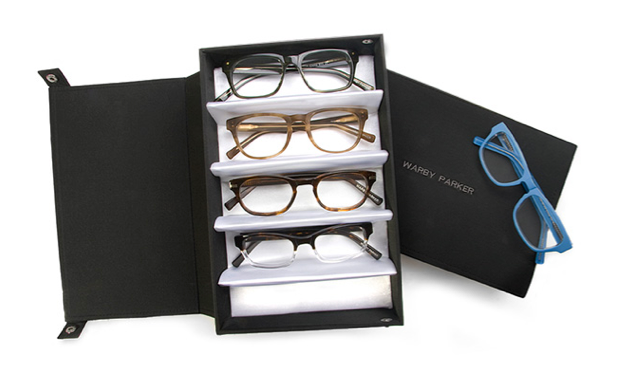From Review of Optometric Business

Image Source: warbyparker.com
Can your practice and optical compete with Warby Parker's phenomenal success?
Warby Parker, which sells eyewear online and at a dozen stores around the country, was named as one of the most innovative companies in 2015. Founded in 2010, it has a simple, but compelling, philosophy: "A lifestyle brand offering value and service with a social mission." Their "buy a pair, give a pair" policy, which gives a pair to charity for every pair sold, has resonated strongly with millennials. "What kind of business do we want to build? [One I can] be excited to go to all day that has a positive impact on the world," said Neil Blumenthal, co-founder. No surprise, then, that WP has sold over one million pairs of glasses and its estimated market valuation is $1.2 billion.
Here are eight ways for an independent OD to compete with Warby Parker:
1. Invest in your own e-commerce store. Like it or not, web-based business models are on the rise, while physical retail stores are on the decline. With more patients purchasing almost everything online, consider investing in an e-commerce store for 24/7 shopping. My practice uses VSP's online portal, Eyeconic. It's been a very affordable and user-friendly way for our patients to purchase contact lenses online, as well as view our frame inventory. Patients can also apply their insurance benefits for purchases online, but only a handful of my patients have done so. There's also Essilor's MyOnlineOptical, which also offers virtual try-on, management of returns, technical support and marketing. There are many resources to help you build a professional online store. eBay offers e-commerce web site support, as well as templates with built-in navigation menus and shopping cart software. At minimum, showcase your "bestsellers" or a "frame of the month" on your web page or Facebook page.
2. Customization for specialized and personalized eyewear. Many online retailers, including Warby Parker, take an "average" for optical center and segment height measurements, based on the frame size. Yet we all know that averages can induce prism and negatively impact quality of vision. First, we always start our patients with a "lifestyle questionnaire," so we can help our patients choose eyewear that best suits them. Second, we utilize a digital measuring device from Hoya that gives the precision and accuracy necessary for today's high-tech lenses. Digitizing pupillary distance, optical center, vertex, pantoscopic tilt and wrap measurement greatly improves lens performance and customer satisfaction. We are able to better communicate the concept of "customized eyewear" and decrease the number of remakes due to measurement error.
3. Connect with your patients in fun and memorable ways. In 2012, Warby Parker played an April Fool's joke with cute dogs wearing their frames. This led to their three highest consecutive sale days of the year. YouTube videos are used to respond to Twitter questions and communicate the message, "We're super-excited about getting you our amazing glasses." Think about creative ways to connect, such as an Instagram contest or Facebook Christmas card photo shop.
4. Make sure the buying experience is engaging, fun and simple. Since people who try on are 50 percent more likely to buy, Warby Parker offers a "5 for 5" deal, meaning you have five days to try on five frames. Warby Parker also encourages their customers to post photos of themselves wearing each potential pair. Co-workers, friends and family become engaged in the selection, which generates word-of-mouth advertisement for Warby Parker. Another reason for Warby Parker's success is, "simplifying the practice of buying glasses. A typical optical shop is confusing and not fun." What about your optical? I encourage my staff to keep things simple and easy: Find out what the patient is interested in and make appropriate recommendations.
5. Stand behind your product. Warby Parker offers a no-questions-asked, 30-day return policy, in addition to a one-year, no-scratch guarantee. It's important to revisit your warranty policy. Many vision care plans have their own warranties; make sure your staff reviews them with your patients. My practice has a "no cash refunds" policy. However, I have trained my opticians to find out what the problems are, and make the necessary changes to solve those problems. We also offer an "in-store" credit, when the eyewear is still unsatisfactory.
6. Competitive pricing with a "value" frame center. Warby Parker started when one of the founders lost a pair of $700 glasses. By cutting out the middleman, Warby Parker offers single-vision eyewear, starting at $95, and $345 for eyewear with a progressive lenses. In my practice, most of our frames alone are in this price range. However, we have a "value" center, with a frame and single-vision lens package, which is competitive with Warby Parker. Many buying groups, frame vendors and optometry alliance groups offer a special deal on close-out frames. I am a member of IDOC, which offers such a deal on our best selling lines. It's important to find a lab that offers competitive pricing, fast turnaround time, second-pair discounts, warranties and quality work. We use ECP Laboratories, which offers these benefits for our private-pay jobs.
7. Charge appropriately for frame adjustments and troubleshooting. Warby Parker will reimburse their customers the cost of one optical measurement (up to $50) within 30 days of purchase. Take advantage of this! We let our patients know that their purchases from us include all measurements, adjustments and repairs. You should charge for these services, if eyewear is bought online.
8. Doctor-driven dispensing. What ultimately sets us apart from Warby Parker, and other online retailers, is that we are the experts! We should not only educate our patients about their glaucoma, macular degeneration and dry eye, but also their visual and eyewear needs. Often, my patient's chief complaint is a simple eyewear problem, such as an incorrect progressive measurement or style, or an issue with the lens material. In my practice, I recommend specific lens materials and options. I am also directly involved in the training of my optical staff. I have personally helped my staff prepare for the American Board of Opticianry exam. It's important that the doctor and opticians are on the same page!
It is extremely telling that in May 2013, Warby Parker opened its first physical retail stores after people asked to try on their glasses in the owners' apartment. It was a "very special experience in that we could build relationships with our customers," WP's founders said. Notably, there are now 12 stores, with plans to open eight more this year. While e-commerce is here to stay, and will only grow in the future, there will always be those who value the in-person interaction with a trained professional. There is a "hands-on" aspect to eyewear that can never be replaced by online retailing--or, as Blumenthal said, "We believe the future of retail is at the intersection of e-commerce and bricks-and-mortar...." Yes, what he said is absolutely true.
How does your practice stay ahead of retailers like Warby Parker? What are the most challenging, and rewarding, aspects of competing with optical retailers like Warby Parker?

Lisa Shin, OD, is the owner of Los Alamos Family Eyecare, P.C., in Los Alamos, N.M. To contact: [email protected]












